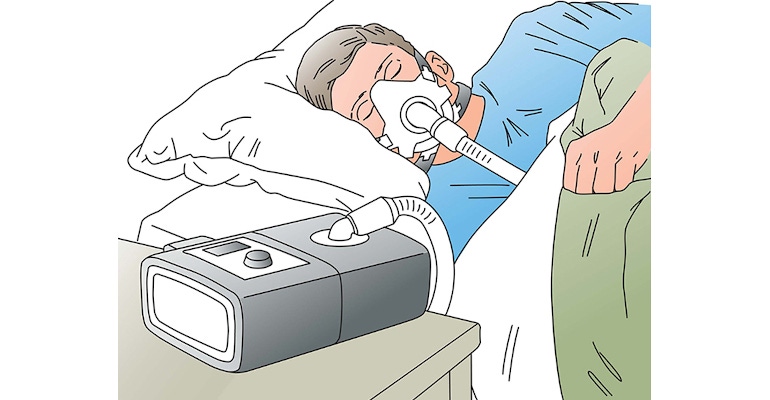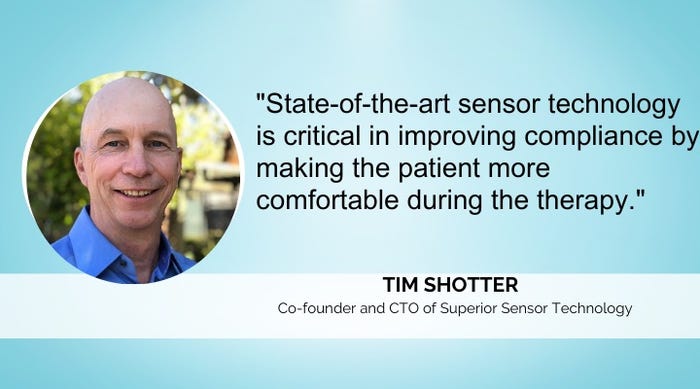How to Build a Better PAP Machine
Sensor technology may help improve sleep apnea therapy adherence by making patients more comfortable with positive airway pressure (PAP) therapy devices.
June 29, 2023

Positive airway pressure (PAP) therapy devices are widely used to treat many of the approximately 30 million people managing sleep apnea in the United States. CPAP (Continuous positive airway pressure) machines are the most common. Many PAP machines are typically used by patients at home, which means that systems should be easy and comfortable to use to promote patient adherence with therapy.
Adherence has been a challenge. According to a data review of CPAP adherence over a 20-year period, adherence ranges between 30 to 60%. Device performance may play a role in encouraging—or hindering—patient adherence. One study found that many factors “are related to discomfort stemming from a variety of sources.”
Device airflow and pressure may be two of those factors. Sensors play a critical role in monitoring patient breathing and synching machine airflow with such breathing patterns. For instance, as Superior Sensor Technology explains in the white paper, “The Importance of Pressure Sensors in Treating Sleep Apnea,” “the most effective airflow sensors have a very fast feedback loop (to tell the system to adjust the fan more quickly when a patient is inhaling/exhaling), are able to effectively block out noise from fans and motors (to reduce error rates), can support multiple pressures without any degradation in performance, and have a high-resolution rate to ensure a very strong signal-to-noise (SNR) ratio.”
Design News asked Tim Shotter, co-founder and CTO of Superior Sensor Technology, a few questions about these sensors and how manufacturers can build better PAP systems.
What role do sensors play in positive air pressure (PAP) therapy machines?
Shotter: PAP machines include several types of sensors to monitor and/or regulate different functions, including airflow, air pressure, and temperature. Without regulating these functions, the machines will not work properly and can cause risk to the user.
Pressure sensors are used to monitor the airflow and air pressure. For example, in a bi-level positive airway pressure (BiPAP) machine, pressure sensors monitor patient breathing. These systems require two pressure sensors: a gauge pressure sensor to control the patient’s pressure and a differential pressure sensor for flow measurement. Specifically, pressure sensors monitor the patient’s breathing and send a signal to the machine to reduce the applied pressure when a patient exhales and then increase it again when the patient inhales. Adjusting the applied pressure when inhaling and exhaling results in the patient being much more comfortable, and no longer ‘fighting’ against the BiPAP machine during exhalation.
What are common challenges engineers face when selecting sensors for PAP machines and how can they be overcome?
Shotter: Researching and finding innovative solutions from a reliable sensor vendor takes time and can be challenging. Engineers want stable supply of sensors with very good long-term stability and reliability. Moreover, they ideally want to utilize sensors that are optimized for PAP machines and are able to overcome noise and interference coming from fans, motors, and external environmental factors.
To overcome these challenges, engineers should research the technology in publications such as Design News and visit vendor websites to learn more about how their sensors can benefit their specific application and download product data sheets, application notes, and CAD models.

What is the benefit of combining the two pressure sensors (gauge and differential) in one device?
Shotter: Combining two pressure sensors in one device has several benefits including simplifying the PCB board design, speeding up manufacturing, streamlining the supply chain, improving system reliability, allowing the PAP device to be smaller in size, and reducing overall cost of the PAP machine.
Why is it important to block out noise from fans and motors from sensors, and how can it be accomplished?
Shotter: Pressure sensors are designed to measure small changes in pressure, and any external noise or interference from fans and motors can introduce errors into the sensor readings. Specifically, the noise gets superimposed onto the pressure reading possibly resulting in patient discomfort due to the inaccurate measurements.
In a PAP machine, pressure sensors are used to measure the airflow and pressure applied to the patient's airway. Any noise or interference that affects the accuracy of the sensor can result in improper pressure being applied. This can lead to respiratory complications, including hypopnea or apnea.
To block out noise so it does not interfere with the signal, you first need to understand the characteristics of the blower noise. Then to avoid mixing it with the band of interest, you design the system to reject the undesired signals. This can be done via the design of an external filter, or it can be accomplished by utilizing Superior Sensor Technology’s advanced digital filtering capability integrated directly in the pressure sensors. Compared with an external filter, an integrated advanced digital filter can respond faster to noise events, simplify product design, and speed time to market.
Why is sensor response time important and how can improving it benefit PAP machines?
Shotter: Sensor response time is the time it takes for the sensor to detect and respond to changes in pressure or airflow. This can impact both patient comfort and PAP machine performance. A fast sensor response time is important because it can detect changes in the patient's breathing patterns quickly and enable the system to adjust the airflow or pressure accordingly. This fast response time improves patient comfort, especially in situations where the breathing patterns change rapidly, such as during periods of sleep disturbance or apnea.
Faster sensor response time improves patient comfort, resulting in better quality of sleep.

PAP machines are becoming increasingly digital in terms of generating and capturing data. How can sensors help improve such data acquisition and handling?
Shotter: Digital machines make more data available to be captured and analyzed. This information can be used to optimize the performance of the PAP machine for each specific patient and even send statistics to their primary care provider. As you integrate more capabilities into the pressure sensors, more data is made available.
The sleep apnea devices market is expected to grow from USD 7.00 Billion in revenue in 2021 to USD 12.88 Billion in revenue 2030. What role does state-of-the-art sensor technology play in making treatment more accessible?
As defined by Medicare, compliance is the measurement of how much you use your CPAP equipment and if it is working for you. Ultimately, a comfortable patient will utilize a PAP machine more frequently. State-of-the-art sensor technology is critical in improving compliance by making the patient more comfortable during the therapy.
The second benefit of state-of-the-art sensor technology is economical. Improvements in sensor technology will include integrating more functionality that today is provided via additional components. Eliminating these components and simplifying the manufacturing process will lower the cost of the machines, making them more likely to be approved by insurance companies and accessible to a wider group of patients.
How can sensors further improve PAP machines for future technological leaps and patient benefits?
Shotter: Integrating sensors with other key components will provide technological leaps to further improve PAP machines. For example, creating a new generation of blowers with integrated sensors will lower system power, reduce costs, and improve patient response times. This will also result in better machine portability, thus expanding their use cases and compliance.
Wearable sensors can potentially be used to monitor the patient's breathing patterns, heart rate, and other vital signs, providing real-time data to adjust treatment. These sensors can be integrated into the PAP mask or worn as a separate device, providing a non-intrusive way to monitor the patient's condition.
Motion sensors can be used to detect the patient's movements during sleep, which can be an indicator of apnea. By detecting the movements, the PAP machine can adjust the treatment parameters to prevent or reduce the severity of apnea events.
Finally, sensors can be used to transmit data wirelessly to healthcare providers, allowing for remote monitoring of the patient. This can help clinicians adjust treatment as needed, improving patient outcomes and reducing the need for in-person visits.
About the Author(s)
You May Also Like



.png?width=300&auto=webp&quality=80&disable=upscale)
